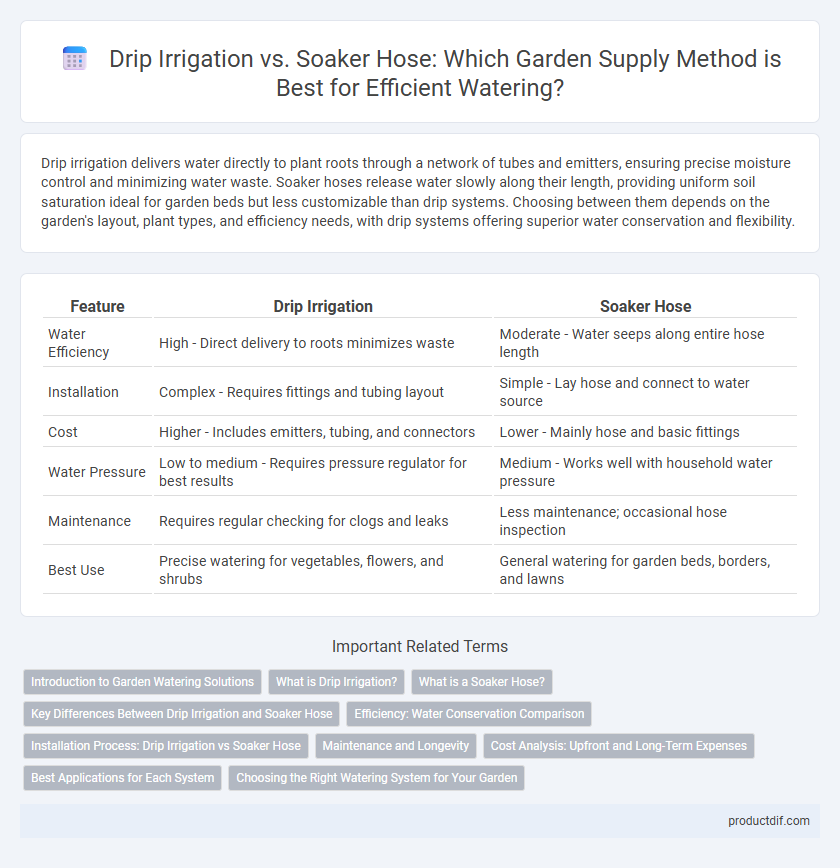Drip irrigation delivers water directly to plant roots through a network of tubes and emitters, ensuring precise moisture control and minimizing water waste. Soaker hoses release water slowly along their length, providing uniform soil saturation ideal for garden beds but less customizable than drip systems. Choosing between them depends on the garden's layout, plant types, and efficiency needs, with drip systems offering superior water conservation and flexibility.
Table of Comparison
| Feature | Drip Irrigation | Soaker Hose |
|---|---|---|
| Water Efficiency | High - Direct delivery to roots minimizes waste | Moderate - Water seeps along entire hose length |
| Installation | Complex - Requires fittings and tubing layout | Simple - Lay hose and connect to water source |
| Cost | Higher - Includes emitters, tubing, and connectors | Lower - Mainly hose and basic fittings |
| Water Pressure | Low to medium - Requires pressure regulator for best results | Medium - Works well with household water pressure |
| Maintenance | Requires regular checking for clogs and leaks | Less maintenance; occasional hose inspection |
| Best Use | Precise watering for vegetables, flowers, and shrubs | General watering for garden beds, borders, and lawns |
Introduction to Garden Watering Solutions
Drip irrigation delivers precise, slow watering directly to plant roots, minimizing water waste and promoting healthy growth in gardens of all sizes. Soaker hoses release water evenly along their length, providing an easy and cost-effective solution for shallow-rooted plants in garden beds. Both methods enhance water efficiency compared to traditional sprinklers, supporting sustainable garden watering practices.
What is Drip Irrigation?
Drip irrigation is a highly efficient garden watering method that delivers water directly to the plant roots through a network of tubes, emitters, and valves, minimizing evaporation and runoff. This system allows precise control of water flow rates, making it ideal for conserving water while promoting healthy plant growth in vegetable beds, flower gardens, and container plants. Compared to soaker hoses, drip irrigation offers customizable irrigation zones and pressure regulation, optimizing water usage and reducing soil erosion.
What is a Soaker Hose?
A soaker hose is a porous garden hose designed to release water slowly and evenly along its length, ideal for deep watering of plants and garden beds. Made from recycled rubber or similar materials, it delivers moisture directly to the soil, reducing water runoff and evaporation. Soaker hoses are often used for efficient irrigation in flower beds, vegetable gardens, and landscaping.
Key Differences Between Drip Irrigation and Soaker Hose
Drip irrigation delivers water directly to plant roots through a network of emitters, offering precise control over water flow and minimizing waste. Soaker hoses release water along their entire length, providing a uniform but less targeted watering solution ideal for densely planted beds. Water efficiency and customization options are key differences, with drip systems typically outperforming soaker hoses in conserving water and supporting diverse plant watering needs.
Efficiency: Water Conservation Comparison
Drip irrigation systems deliver water directly to plant roots with precise control, reducing water waste by up to 50% compared to traditional methods. Soaker hoses distribute water more evenly along their length but can lose efficiency due to evaporation and runoff, especially on uneven terrain. Overall, drip irrigation offers superior water conservation by minimizing evaporation and targeting specific plant zones.
Installation Process: Drip Irrigation vs Soaker Hose
Drip irrigation systems require precise installation involving emitter placement and tubing layout to ensure uniform water distribution, often needing pressure regulators and filters for optimal performance. Soaker hoses offer a simpler setup, typically requiring just laying the hose along plant rows and connecting it to a water source without extensive customization. Both methods benefit from careful planning, but drip irrigation demands more technical components and adjustments compared to the straightforward installation of soaker hoses.
Maintenance and Longevity
Drip irrigation systems require regular flushing and filter cleaning to prevent clogs and extend lifespan, while soaker hoses demand less maintenance but are prone to wear and cracking over time. Proper winterizing of both systems significantly enhances durability, with drip systems often lasting 5 to 7 years versus soaker hoses averaging 3 to 5 years under similar conditions. Choosing quality materials and performing seasonal inspections directly influence the longevity and efficiency of garden watering tools.
Cost Analysis: Upfront and Long-Term Expenses
Drip irrigation systems typically have higher upfront costs due to emitters, tubing, and pressure regulators compared to soaker hoses, which are generally less expensive and easier to install. Over time, drip irrigation offers more precise water delivery, leading to reduced water usage and lower utility bills, whereas soaker hoses may require more frequent replacement due to wear and clogging. Considering maintenance and water efficiency, drip irrigation provides better cost savings in long-term garden supply budgeting.
Best Applications for Each System
Drip irrigation systems excel in delivering precise, targeted watering directly to plant roots, making them ideal for vegetable gardens, flower beds, and container plants that require consistent moisture levels. Soaker hoses are best suited for watering larger, densely planted areas like garden borders and shrub beds, providing a slower, more even water distribution across the soil surface. Both systems conserve water efficiently, but choosing between them depends on the plant type, garden layout, and irrigation uniformity needed.
Choosing the Right Watering System for Your Garden
Drip irrigation delivers targeted water directly to plant roots through a network of tubes and emitters, maximizing water efficiency and minimizing evaporation. Soaker hoses release water along their entire length, making them ideal for evenly watering garden beds or rows of plants with less setup required. Selecting between them depends on your garden layout, plant types, and water conservation goals to ensure optimal growth and resource use.
Drip irrigation vs Soaker hose Infographic

 productdif.com
productdif.com